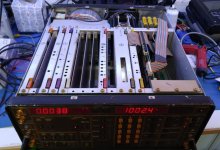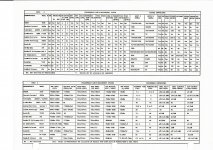I have been aware of these for years and one at an attractive price came up so I grabbed it. It is huge and heavy. by far the heaviest analyzer I have encountered. Also the deepest at something like 20".
This one mostly works. Having gone through some basic testing it seems that out of range signals on the input generate error messages. (Made it cheaper on eBay.) The generator seems really good with all the harmonics below -120dB at first look. I'll go back and check. The analyzer side notched really deep but has a serious 3rd harmonic issue at around -80 dB. The metering all seems OK. The internal batteries were all toast (no surprise).
I was promised a manual to scan which I will do and share when it gets here.
Below is a picture showing the internal organization and loopback distortion.
I'll share more as I progress.
This one mostly works. Having gone through some basic testing it seems that out of range signals on the input generate error messages. (Made it cheaper on eBay.) The generator seems really good with all the harmonics below -120dB at first look. I'll go back and check. The analyzer side notched really deep but has a serious 3rd harmonic issue at around -80 dB. The metering all seems OK. The internal batteries were all toast (no surprise).
I was promised a manual to scan which I will do and share when it gets here.
Below is a picture showing the internal organization and loopback distortion.
I'll share more as I progress.
Attachments
Actual dimensions-
16" wide, 19" deep and 7" high. Its heaver than many classic power amps. Its really almost too large for an upper shelf. Here in earthquake country its a real consideration. The same is true for most of the other SOTA analyzers. At least the weight is at the back of the box. I like that I can adjust the trimmers with the boards in place. I need extender cards for the Shibasoku and the Boonton.
16" wide, 19" deep and 7" high. Its heaver than many classic power amps. Its really almost too large for an upper shelf. Here in earthquake country its a real consideration. The same is true for most of the other SOTA analyzers. At least the weight is at the back of the box. I like that I can adjust the trimmers with the boards in place. I need extender cards for the Shibasoku and the Boonton.
The width and height is not too bad, but that depth is a lot to deal with. I'd need a cart to sit it on for sure as it would eat up way too much of my limited bench space. I noticed the numbered boards and access holes, it seems like a somewhat service friendly design.
Having sold AP gear for more than a dozen years, I was quite accustomed to lugging 35 pound boxes and hating every minute of it. I also couldn't fit them on the desk of my home office.Actual dimensions-
16" wide, 19" deep and 7" high. Its heaver than many classic power amps. Its really almost too large for an upper shelf. Here in earthquake country its a real consideration. The same is true for most of the other SOTA analyzers. At least the weight is at the back of the box.
These days I am quite enjoying our new AverLAB audio analyzer because it is the size of a cigar-box and weighs under 6 pounds. I can carry it on planes in a standard 15" laptop bag along with my computer.
The QA400 I have is a light and portable piece. It may not have the capabilities of the AverLAB unit, but its very inexpensive in comparison. I took an old plastic medical case I had and cut it out to fit the QA snugly into it along with a good bundle of BNC cables and adapters. In addition to making it more portable the case makes a good protective storage box too.
That Panasonic 7722 is still great machine. I bought 2 cheap. Just needs an internal memory battery replacement every 10 years.
THx-RNMarsh
THx-RNMarsh
Murray- On the spreadsheet it mentions software for the Amber 5500. What is that referring to? Is there a GPIB based app somewhere for it?
I would really like to find someone skilled in Visual Basic to help write a standard app for tests with a number of these instruments.
I would really like to find someone skilled in Visual Basic to help write a standard app for tests with a number of these instruments.
Been a big fan of Amber equipment for quite a while. Have a few 4400(a)s around and it/they work just fine for my needs.
Knew of the 5500. Not sure how many were produced but opine not many. Have the original product brochure dated 1986.
Unfortunately it appears that to be really useful, the machine had to be equipped with a number of (hardware/software) - 001/Balanced Output; 002/IMD; 004/Wow and Flutter; 005/Audio Filter Weighing; 007/Stereo Output; 009/Phase Measurement; 200/High Speed CPU; 201/High Performance Group. The "really tasty" option was 054 a "High Speed Plotting System - high speed, high resolution graphs of frequency response, THD / IM [down to -120dB] versus frequency, spectrum analysis and phase versus frequency" . 054 details were listed in a separate (later) flyer and makes me wonder if any were ever built. Believe that Wayne Jones had left the company for AP around (or by) that time.
Kevin Kennedy has a 5500 for sale with the manual.
Charles
Knew of the 5500. Not sure how many were produced but opine not many. Have the original product brochure dated 1986.
Unfortunately it appears that to be really useful, the machine had to be equipped with a number of (hardware/software) - 001/Balanced Output; 002/IMD; 004/Wow and Flutter; 005/Audio Filter Weighing; 007/Stereo Output; 009/Phase Measurement; 200/High Speed CPU; 201/High Performance Group. The "really tasty" option was 054 a "High Speed Plotting System - high speed, high resolution graphs of frequency response, THD / IM [down to -120dB] versus frequency, spectrum analysis and phase versus frequency" . 054 details were listed in a separate (later) flyer and makes me wonder if any were ever built. Believe that Wayne Jones had left the company for AP around (or by) that time.
Kevin Kennedy has a 5500 for sale with the manual.
Charles
Murray- On the spreadsheet it mentions software for the Amber 5500. What is that referring to? Is there a GPIB based app somewhere for it?
I would really like to find someone skilled in Visual Basic to help write a standard app for tests with a number of these instruments.
Amber produced a software package called AudioCheck.
I arranged for a friend to get a loaded 5500 direct from Amber. He became friends with Wayne Jones who created custom macros for his reviewing activities under AudioCheck. I'm not exactly sure where all this eventually went, but the last stuff I saw was for mass testing and plotting sinad of FM tuners and testing cassette recorders and tapes for magazine shootouts. This was all under GPIB control with a 7475A plotter and 3561A spec-an. An ST1000 was modulated by pre-emphasised signals from the 5500 to torture tuners at wide high frequency deviation.
I had a working demo (5 1/4 floppy stuff) of AudioCheck but it's long gone. I'm not sure how heavily marketed AudioCheck was because most of our 5500 customers were government and telecoms who integrated them in their ATE under GPIB.
Murray
I stumbled across this audio site a while back. Based on the info on this page it looks like these folks came up with some sort of custom programming for their Amber 5500. You might contact them to see how receptive they are to sharing.
I saw the measurements they made some time ago. One of the reasons i was interested in the 5500. I had one of the very first Amber analyzers (3000?) many years ago. They always had very high performance and it seems overstuffed boxes.
I got the manual. Scanning will happen next week.
The 5500 is running and I have a better idea of whats in it and what its capabilities are. This example does not have IM second channel out Phaes options. It does have the DC meter.
The source side is very good with up to 14V at very low distortion. I'll do a proper tweak before getting real numbers but its below .0005%. The Analyzer has an issue. High 3rd harmonic. That seems to be what is limiting the floor to .003%.
Overall its nice. Without the options its pretty analogous to the Boonton 1120 in capability. The notch depth is better but until i get that 3rd down its limited. I'll explore it for a while and will share whatever I learn.
The 5500 is running and I have a better idea of whats in it and what its capabilities are. This example does not have IM second channel out Phaes options. It does have the DC meter.
The source side is very good with up to 14V at very low distortion. I'll do a proper tweak before getting real numbers but its below .0005%. The Analyzer has an issue. High 3rd harmonic. That seems to be what is limiting the floor to .003%.
Overall its nice. Without the options its pretty analogous to the Boonton 1120 in capability. The notch depth is better but until i get that 3rd down its limited. I'll explore it for a while and will share whatever I learn.
I finally have the manual scanned. it was a bigger chore than i first thought but a softwaere update got it handled. e-mail me if you want a copy. Its 300 MB.
Here is a comparison of competing audio analyzers done by Amber's Wayne Jones, September 89. By April 91 he was director of technical support at Audio Precision.
Murray,
Did Wayne Jones September 1989 tables comparing competing audio analyzers appear in a magazine article? If so, what magazine was it? If not, then where did it come from?
Thanks!
Ed
I have two of these, one with balanced I/O and the IMD option (quite rare). Was my main measurement tool until I got a Rohde UPD and a couple of 7722's. The Amber 5500 performance is equivalent with an AP System 1 but sorely misses the computer automation. A good opportunity for the enthusiast to exercise his VB programming skills.
The 5500's need a periodic adjustment of several parameters (CMRR, notch, etc...) the manual has all the procedures. The batteries are in fact 4 AA rechargeable cells, trickle charged when the unit is on. Replace them with NiCd and forget about for the rest of your life.
I still use one of these 5500's as the first line of testing (before engaging the UPD) and for all quick evaluations. The other one is waiting as a spare part unit, just in case something bad happens. I hate the 7722's for the missing balanced I/O.
The 5500's need a periodic adjustment of several parameters (CMRR, notch, etc...) the manual has all the procedures. The batteries are in fact 4 AA rechargeable cells, trickle charged when the unit is on. Replace them with NiCd and forget about for the rest of your life.
I still use one of these 5500's as the first line of testing (before engaging the UPD) and for all quick evaluations. The other one is waiting as a spare part unit, just in case something bad happens. I hate the 7722's for the missing balanced I/O.
Last edited:
- Home
- Design & Build
- Equipment & Tools
- Amber 5500 audio analyzer

